Mobility Efforts in Mexico City
By Jenn Hendricks
The following piece is part of Progressive City's Planning for Environmental Justice series. Contributions reflect on this theme through a variety of lenses, such as environmental justice, combatting green gentrification, and exploring radical approaches to climate change. Read more about this series here.

Latin America’s incredible urban growth has outpaced city planning and infrastructure. As a result, close to one-fourth of the urban population lives in informal housing. Like any sprawling region, Latin American cities often experience fragmentation in social and physical aspects of society, resulting in disparity and inequity. For instance, workers in Lima and Bogotá spend half as much time commuting as they do at work. A lack of public transit has morphed into an overreliance on cars, in turn creating some of the most congested cities in the world. When car culture dictates the movement of a city, efficiency, space and air quality are negatively impacted. Data shows that cycling has the potential to save cities $25 trillion, while reducing transportation-related CO₂ emissions 10 percent by 2050. Introducing infrastructure that supports and encourages biking is a complex and sustainable solution that eases congestion and pollution while promoting public health and equity.
Dialogue surrounding sustainable mobility options has largely focused on major European cities like Amsterdam and Paris. Exploring biking initiatives in Latin America offers nuance to the discussion of urban planning and policy. As the second most urbanized region in the world, Latin America faces unique challenges while offering insight into repurposing street space for recreation. Closing streets to cars offers the chance to explore more complex ideas of public space. Communities can begin to examine how they want to use public space and showcase their values through thoughtful urban planning.
Bogotá’s much acclaimed Ciclovías has proved a template for the region and the world. In 1974, the movement toward a car-free city was started by 5,000 Bogotáns who were tired of a car-centric city. What initially started as a protest, with demonstrators fighting to alleviate pollution and reclaim public space for recreation, turned into a weekly event in which streets are closed down exclusively for pedestrians or cyclists. Not long after, many other Latin American cities developed their own urban experiment in non-motorized transportation.
One of the places to follow Bogota’s example was Mexico City. Famous for its smog and sprawl, the mountainous metropolis is the twenty-third most congested in the world, and drivers lose 67 hours in traffic per year. Mexico City is situated in the crater of an extinct volcano and has an altitude of 7,349 feet, this particular geography causes incomplete fuel combustion in engines resulting in higher emissions of carbon monoxide. In addition, smog levels can reach higher than normal levels with increased sunlight. Mexico City’s toxic mix of an older vehicle fleet, geography and growing populace led to the United Nations naming the city the most polluted in the world in 1992. Air pollution in the city contributed to thousands of hospitalizations and roughly 1,000 premature deaths a year. Since then, city leadership has been proactive in curbing pollution, emphasizing car-free mobility.
The city has sponsored a surge in bike-sharing systems, e-bikes, and other forms of micro-mobility. The citizenry is starting to take control of their public space by embracing alternative urban mobility. One example of this is EcoBici, which helps establish alternative forms of transit. EcoBici is the largest bike share system in Latin America, covering over 13.5 square miles and with extensive growth expected. It serves 100,000 registered riders and is accessible everyday. According to official city statistics, 54% of Ecobici users substituted another form of transport for cycling.

The city is also host to free bike lessons and a massive Sunday Ciclovía, during which major roads are transformed into an enormous pedestrian and bicycle corridor. Mexico City’s Sunday Ciclovía weaves through close to 250 miles of streets including through Paseo de la Reforma, sections of the historic center, and various streets in the southern part of the city. The current administration, under Mayor Claudia Sheinbaum, seeks to expand the route to 373 miles by 2024. In addition to the expansive network, free bikes are available for use from various loan stations throughout the route. By providing free bike lessons and bike use, the program runs on a democratic system that allows an inclusive group of people to participate.
A multifaceted transit network is not complete without protective measures for cyclists and pedestrians. The Mexican government has also been actively trying to improve road safety through legislation. This May, it successfully passed legislation called the General Mobility and Road Safety bill, which creates a legal framework for cyclists and pedestrians in response to the high numbers of road traffic deaths. The law addresses vehicle safety standards and recognizes the rights of crash victims.
Car-centric cities isolate and push people apart, ultimately threatening citizen health and safety. According to a study on the Ciclovia pedestrian zone in Bogotá, people felt safer in these zones compared to those that did not use car free streets. People also reported that they felt more trusting of others in the shared space. The objective of developing a sustainable transportation system relies on creating a different system for motorized vehicles, but in decreasing traffic and moving toward collective modes of transit.Thriving and sustainable cities are successful when they bring people together. Infrastructure that supports biking and walking reflect an inclusive and safe space for the public to coexist. Ciclovías have taken root across the Latin American urban landscape, demonstrating that a people-first approach to public space improves quality of life. Accessible public space encourages socialization and gives communities a feeling of connectivity and safety.
Jenn Hendricks is a Brooklyn-based freelance writer and urban researcher. She is a graduate of Hunter College Department of Urban Policy and Planning. Her work focuses on comparative urban policy, with a specific interest in regional understandings of community development and public space. She can be found here.


Comments